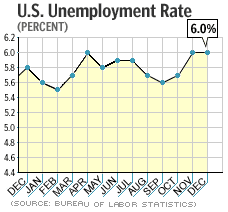NEW YORK (CNN/Money) -
Employers slashed payrolls at a surprisingly aggressive pace in December, the government reported Friday, another sign that the labor market will be slow to recover from the heavy job cutting that followed the recession of 2001.
Meanwhile, the unemployment rate held steady at 6 percent, the Labor Department said, but that may have been due to a large number of people who gave up looking for work last month, meaning they are not counted in the government's statistics. December's job cuts -- the most in 10 months -- came after a revised loss of 88,000 jobs outside the farm sector in November, the department said in its report.
The cuts pointed to surprising weakness in the job market, economists said, just days after President Bush unveiled his plan to stimulate the economy and boost job growth. Economists had forecast that 20,000 jobs were created last month, according to a survey by Briefing.com.

"There were close to 200,000 jobs cut in the past couple of months, making them the worst two months of last year," Jared Bernstein, labor economist at the Economic Policy Institute, told CNNfn's CNNmoney Morning program. "The jobless recovery is not only lingering, it's deepening."
On Wall Street, stocks sank initially after the report, but later bounced back. Treasury bond prices rose.
The news could put added pressure on Congress to pass quickly an economic stimulus plan. On the first day of its new session this year, Congress passed an extension of unemployment benefits for the many workers whose benefits expired at the end of 2002.
The president's economic plan, announced Tuesday, proposed creating "re-employment accounts" of about $3,000 to help 1.2 million unemployed workers with job training, child care and other costs.
Bush also proposed massive tax cuts that he claims will add 2.1 million new jobs to the economy in the next three years. But some economists worry that the economy needs stimulus more quickly than that.
| 
| |

| 
| 
|

|
 Labor Secretary Elaine Chao comments on the unemployment numbers and overall job market. Labor Secretary Elaine Chao comments on the unemployment numbers and overall job market.
|
|
Play video
(QuickTime, Real or Windows Media)
|
| 
|

|
|
"Lawmakers need to focus on stimulus, and this report is really a wake-up call in that regard," Bernstein said.
U.S. businesses cut more than 1.8 million jobs during the recession of 2001 and the stop-and-start recovery in 2002.
With financial markets struggling, an abundance of unused production capacity and fears about a possible war in Iraq, businesses have been reluctant to hire until they're sure the economy has its legs again.
Still, 6 percent unemployment is relatively low, compared with a peak of 7.8 percent during the 1990-91 recession and 10.8 percent in 1982. Still, it matches the highest level since August 1994 and has budged little since December 2001.
Before Friday's report, economists were divided about the strength of temporary hiring in the retail sector for the holiday season. Retailers had cut 40,000 jobs in November and some economists hoped they would hire temporary workers later in the season.
They didn't; in fact, retailers slashed 104,000 jobs in December, the most of any sector. Still, the bulk of those cuts -- 80,000 -- were made at bars, restaurants and food stores.
Manufacturers, meanwhile, cut 65,000 jobs. That sector has been the hardest hit of any during the recession that began in March 2001 and a sluggish recovery in 2002.
In another grim sign, the average work week shrank by 0.1 hour to 34.2 hours. If the workers businesses already have are working less, they have little incentive to hire more.
"The decline in the length of the average work week ... tells us this leading employment indicator does not foreshadow any immediate end to this general pattern of weakness in the labor market," said Anthony Chan, chief economist at Banc One Investment Advisors.
Meanwhile, many unemployed workers are apparently giving up their job searches. The labor force -- the pool of employed workers and unemployed workers looking for jobs -- shrank by 191,000 in December to 142.5 million. Of that number, 8.6 million -- or about 6 percent -- were unemployed.
On a brighter note, the average manufacturing work week jumped to 40.9 hours, the highest level since August 2002, from 40.6 in November. The gain, combined with a positive report by the nation's purchasing managers about manufacturing activity in December, could indicate that the manufacturing sector might be getting closer to recovery.
And workers' income continued to rise, as average hourly earnings gained 5 cents to $14.98.

|

